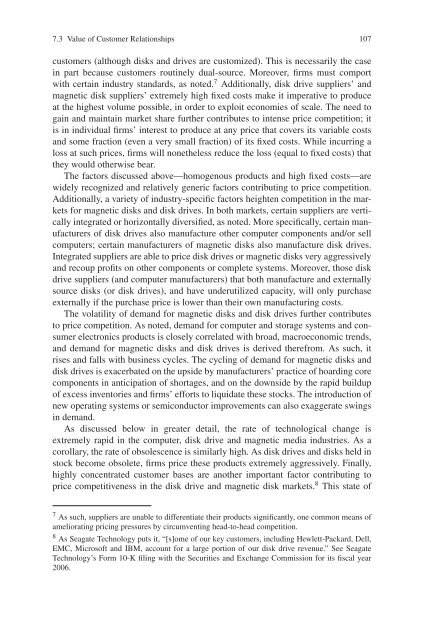Contents - AL-Tax
Contents - AL-Tax
Contents - AL-Tax
You also want an ePaper? Increase the reach of your titles
YUMPU automatically turns print PDFs into web optimized ePapers that Google loves.
7.3 Value of Customer Relationships 107customers (although disks and drives are customized). This is necessarily the casein part because customers routinely dual-source. Moreover, firms must comportwith certain industry standards, as noted. 7 Additionally, disk drive suppliers’ andmagnetic disk suppliers’ extremely high fixed costs make it imperative to produceat the highest volume possible, in order to exploit economies of scale. The need togain and maintain market share further contributes to intense price competition; itis in individual firms’ interest to produce at any price that covers its variable costsand some fraction (even a very small fraction) of its fixed costs. While incurring aloss at such prices, firms will nonetheless reduce the loss (equal to fixed costs) thatthey would otherwise bear.The factors discussed above—homogenous products and high fixed costs—arewidely recognized and relatively generic factors contributing to price competition.Additionally, a variety of industry-specific factors heighten competition in the marketsfor magnetic disks and disk drives. In both markets, certain suppliers are verticallyintegrated or horizontally diversified, as noted. More specifically, certain manufacturersof disk drives also manufacture other computer components and/or sellcomputers; certain manufacturers of magnetic disks also manufacture disk drives.Integrated suppliers are able to price disk drives or magnetic disks very aggressivelyand recoup profits on other components or complete systems. Moreover, those diskdrive suppliers (and computer manufacturers) that both manufacture and externallysource disks (or disk drives), and have underutilized capacity, will only purchaseexternally if the purchase price is lower than their own manufacturing costs.The volatility of demand for magnetic disks and disk drives further contributesto price competition. As noted, demand for computer and storage systems and consumerelectronics products is closely correlated with broad, macroeconomic trends,and demand for magnetic disks and disk drives is derived therefrom. As such, itrises and falls with business cycles. The cycling of demand for magnetic disks anddisk drives is exacerbated on the upside by manufacturers’ practice of hoarding corecomponents in anticipation of shortages, and on the downside by the rapid buildupof excess inventories and firms’ efforts to liquidate these stocks. The introduction ofnew operating systems or semiconductor improvements can also exaggerate swingsin demand.As discussed below in greater detail, the rate of technological change isextremely rapid in the computer, disk drive and magnetic media industries. As acorollary, the rate of obsolescence is similarly high. As disk drives and disks held instock become obsolete, firms price these products extremely aggressively. Finally,highly concentrated customer bases are another important factor contributing toprice competitiveness in the disk drive and magnetic disk markets. 8 This state of7 As such, suppliers are unable to differentiate their products significantly, one common means ofameliorating pricing pressures by circumventing head-to-head competition.8 As Seagate Technology puts it, “[s]ome of our key customers, including Hewlett-Packard, Dell,EMC, Microsoft and IBM, account for a large portion of our disk drive revenue.” See SeagateTechnology’s Form 10-K filing with the Securities and Exchange Commission for its fiscal year2006.
















